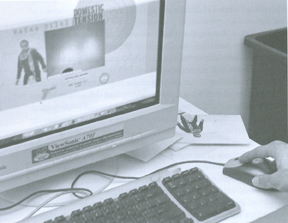Image from "Shoot an Iraqi," 2007.
Shoot an Iraqi: Art, Life, and Resistance Under the Gun
By Wafaa Bilal and Kari Lydersen
City Lights, 2008.
It has been observed that art does not, in fact, imitate life. Art can only, and at best, hold up an imperfect mirror to life, one which exaggerates certain elements while neglecting others. Perfect imitation is never possible.
Wafaa Bilal’s “Domestic Tension” interactive art installation went far in smoothing out the wrinkles in the imperfect mirror of art. His experiences creating, implementing and living in his installation are chronicled in the book “Shoot an Iraqi.” The book gathers Bilal’s reflections on the “Domestic Tension” experience, as well as recounting his own life growing up in Iraq.
“Domestic Tension” relied upon numerous cultural inputs for its execution. The basic premise was to create a space in which Bilal would be under constant threat from being literally shot at. A paintball gun was rigged to a robotic armature, and this gun was controlled and fired by someone logging on to a website, and targeting Bilal while he worked, ate and slept in a gallery space dedicated to the installation. By making the firing mechanism available through a web-based interface, Bilal exposed the voyeuristic and disembodied aspects of postmodern warfare. Contemporary warfare has entered the realm of the virtual, where presence is telematic, and death is delivered from a distance. The parallel created is that between online gaming and computer-based warfare, where unmanned drones and cruise missiles are guided by a computer operator hundreds of miles from the eventual destination of destruction.
Bilal also set up a chat room where the participants could talk to one another and himself. The chat room revealed that depersonalized violence can often expose, or even generate, violent attitudes, as numerous participants spewed forth venomous comments such as “shoot the rag head” and “kill him.” In some sense, “Domestic Tension” shows us how when we don’t have to actually confront a living person, it becomes easier to hate them, easier to want to shoot and kill them.
The book collects diary-like entries that recall the challenges, technical issues and personal recollections of the artist. We find out that a hacker managed to infiltrate the program and found a way to override the firing mechanism and turn the paintball gun into a fully automatic weapon. More poignantly, Bilal reflects upon the stress and fear of living under constant threat. However, like many people who live under the unrelenting strain of fear, eventually even Bilal grows numb. On day 20 he recalls, “I’ve realized I have lost fear of the gun... This is a dangerous development, because when you get cavalier and careless you get hurt.” The artist becomes a gateway into the personal, the intimate experience of someone in war (or warlike conditions simulated through artifice). And this is perhaps where both the installation and the companion book achieve their greatest success. Bilal effectively challenges us to go past the computer screen, go beyond the telematic presence of virtual battlefields and television news graphics, and to delve into the hearts and minds of the besieged. Thus, he includes not just a diary of his days under the paintball gun, but also reveals intimate stories about life growing up in Iraq. Bilal’s portraits of family life in a country under constant siege expose strain, fear, heartbreak, dislocation and even occasionally black humor. The reader is confronted with an honest and sparse tale of ordinary Iraqi’s suffering in the crossfire.
Hope prevails in Wafaa Bilal’s story. He escapes the wars, the refugee camps, and eventually comes to Chicago to pursue the artistic visions that provided him solace during American bombing campaigns. And even in the occasionally vicious violence of the “Domestic Tension” chat room, others logged on and found ways to support and protect Bilal during the installation. Both the artwork and its accompanying diary shows us the potential of personal narrative to transmit feelings that are universal to humanity.
This article appeared in Al Jadid Magazine, Vol. 15, No. 61, 2009.
Copyright © 2009 AL JADID MAGAZINE

